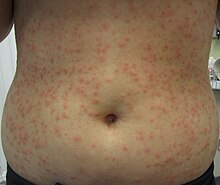Hot tub folliculitis
| Hot tub folliculitis | |
|---|---|
| Other names | Pseudomonas aeruginosa folliculitis |
 | |
| Pseudomonas folliculitis, also known as hot tub folliculitis | |
| Specialty | Dermatology |
| Symptoms | Rash, with variable amounts of itching and pain |
| Usual onset | 24-72 hours after exposure |
| Duration | 1-2 weeks |
| Causes | Exposure to contaminated water source |
| Diagnostic method | Based on symptoms combined with patient history of swimming |
| Treatment | Antibiotics |
Hot tub folliculitis, also called Pseudomonal folliculitis or Pseudomonas aeruginosa folliculitis, is a common type of folliculitis featuring inflammation of hair follicles and surrounding skin.[1]: 272
This condition is caused by an infection of the skin and hair follicles by the bacterium Pseudomonas aeruginosa. The bacterium is commonly found in poorly-maintained recreational water sources such as hot tubs, water slides, and swimming pools.[2] Hot tub folliculitis appears on the skin in the form of a rash, roughly resembling chicken pox and then develops further to appear as a pimple.[3] Children are the most likely to be affected.[4] Hot tub folliculitis can be, but is not always, painful and/or itchy.[5]
In most cases, the rashes resolve after about 7 to 10 days, only leaving a hyperpigmented lesion that goes away after a few months. Oral antibiotics such as ciprofloxacin may be used to shorten the duration of symptoms.[2][6][7]
Cause
[edit]This condition typically occurs after exposure to contaminated water, such as in hot tubs, whirlpools, or swimming pools. Pseudomonas aeruginosa is a waterborne bacterium that thrives in warm, moist environments.[8]
The bacterium is known to penetrate the skin through either the natural openings in hair follicles or through small breaks in the skin. The rash and symptoms known as folliculitis in this case apply to the skin eruptions that occur following immune response to the infected areas.[8][2]
Diagnosis
[edit]Clinical suspicion of P. aeruginosa folliculitis usually begins with a combination of the rash's appearance and a history of swimming or hot tub use 24-72 hours before the onset of symptoms. The most common locations for the rash include the upper thorax, the axillary folds, the hips and buttocks, and the areolas. Areas covered by bathing suits are more likely to become infected. The head is usually not affected.[5][9]
Treatment
[edit]Most people do not require treatment and will see the rash resolve on its own within 1-2 weeks. However, those who are immunocompromised are at increased risk, and should always receive treatment with antibiotics.[2] Pseudomonas aeruginosa presents additional challenges when antibiotics are used, because many strains of the organism are resistant to a wide range of medications.[10] The most commonly used antibiotics for hot tub folliculitis are ciprofloxacin and/or gentamicin.[2]
See also
[edit]References
[edit]- ^ James, William D.; Berger, Timothy G.; et al. (2006). Andrews' Diseases of the Skin: Clinical Dermatology. Saunders Elsevier. ISBN 0-7216-2921-0.
- ^ a b c d e Hardin, J. Matthew (2021). "Hot Tub Folliculitis/Pseudomonas Hot-Foot Syndrome". The Atlas of Emergency Medicine (5th ed.). New York: McGraw Hill.
- ^ "Swimmer's Itch and Hot Tub Folliculitis". Advanced Dermatology. May 23, 2019. Retrieved November 19, 2020.
- ^ "Hot Tub Folliculitis: Rash, Symptoms, Causes & Treatment". Cleveland Clinic. Retrieved 2023-01-02.
- ^ a b Mordorski, Breanne; Friedman, Adam J. (2019). "Chapter 154: Gram-Negative Coccal and Bacillary Infections". Fitzpatrick's Dermatology (9th ed.). New York: McGraw Hill.
- ^ "Hot Tub Rash | Healthy Swimming | Healthy Water | CDC". www.cdc.gov. 2022-05-17. Retrieved 2023-01-02.
- ^ Goodheart, Herbert P. (2010). Goodheart's same-site differential diagnosis : a rapid method of diagnosing and treating common skin diseases. Philadelphia, Pa.: Lippincott Williams & Wilkins. p. 296. ISBN 978-1605477466.
- ^ a b Yu, Yue; Cheng, Amy S.; Wang, Lawrence; Dunne, W. Michael; Bayliss, Susan J. (October 2007). "Hot tub folliculitis or hot hand–foot syndrome caused by Pseudomonas aeruginosa". Journal of the American Academy of Dermatology. 57 (4): 596–600. doi:10.1016/j.jaad.2007.04.004. ISSN 0190-9622. PMID 17658195.
- ^ Bhatia, Ashish; Brodell, Robert T. (Jan 1999). "'Hot tub folliculitis': Test the waters—and the patient—for Pseudomonas". Postgraduate Medicine. 106 (4): 43–46. doi:10.3810/pgm.1999.10.1.730. ISSN 0032-5481. PMID 10533506.
- ^ Langendonk, R. Frèdi; Neill, Daniel R.; Fothergill, Joanne L. (2021-04-16). "The Building Blocks of Antimicrobial Resistance in Pseudomonas aeruginosa: Implications for Current Resistance-Breaking Therapies". Frontiers in Cellular and Infection Microbiology. 11: 665759. doi:10.3389/fcimb.2021.665759. ISSN 2235-2988. PMC 8085337. PMID 33937104.
